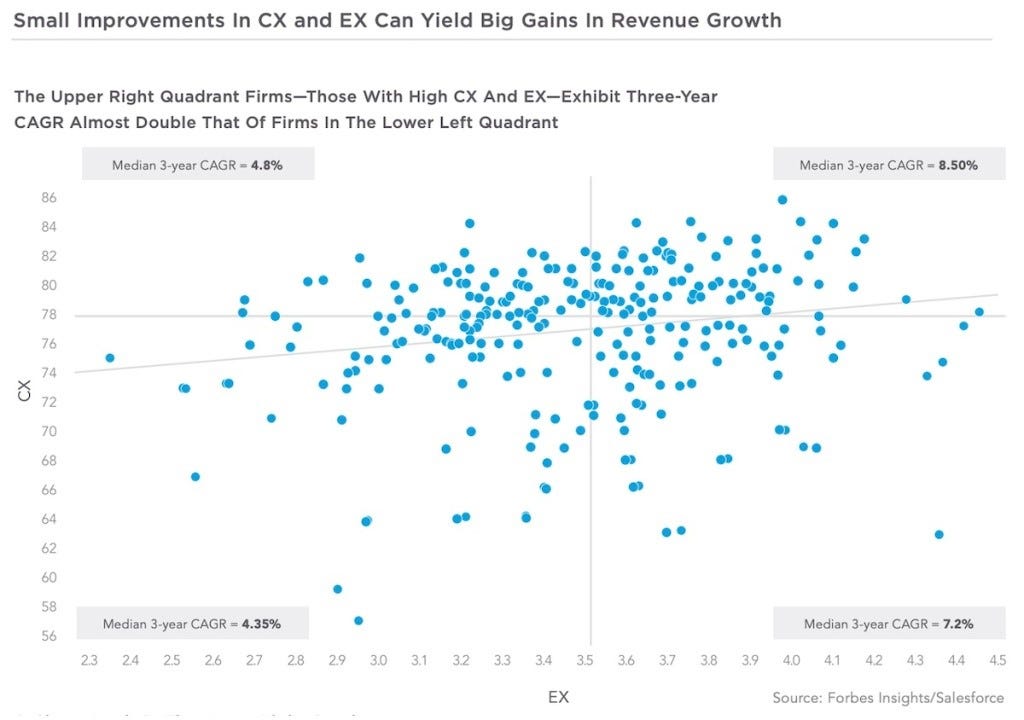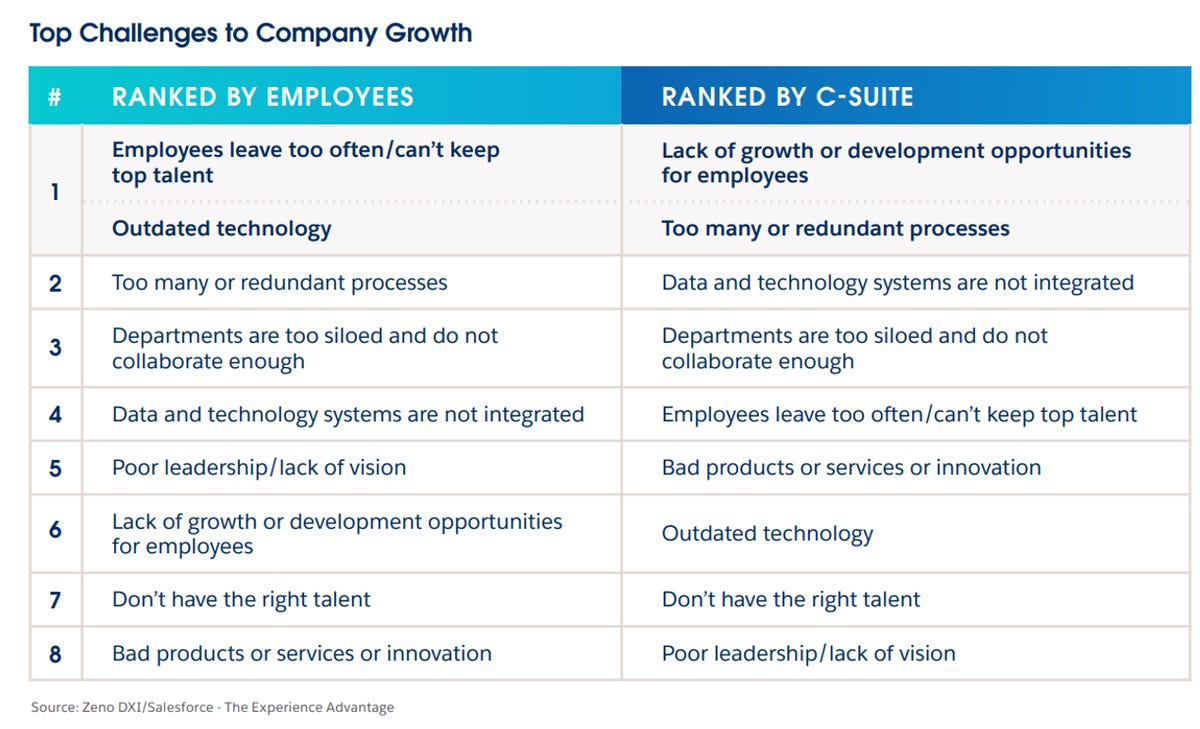5 elements of employee experience that impact customer experience and revenue growth

A better customer experience drives revenue growth. To improve the customer experience, start with the employee experience.
Research shows the relationship between employee experience (EX) and customer experience (CX) and its impact on accelerated growth. But can we quantify the direct impact an increased focus on employee experience has on growth? To answer this question, Salesforce surveyed more than 4,100 C-level executives and employees across 12 markets to identify the key elements of EX that drive CX and increase revenue.
The Experience Advantage
The Experience Advantage is the summary report of the survey findings.
Here are the key takeaways of the Experience Advantage:
- Companies are leaving money on the table. Breaking silos between employee experience and customer experience can lead to a massive opportunity for revenue growth of up to 50% or more.
- Companies think they have to choose between prioritizing employee or customer experiences. And customer experience is winning. Approximately nine in 10 C-suite members (88%) say employees are encouraged to focus on customers’ needs above all else, even though the C-suite knows that a powerful customer experience starts with an employee-first approach.
- Five core elements of employee experience impact customer experience and growth: Trust, C-Suit Accountability, Alignment, Recognition, and Seamless Technology.
- There is a disconnect between C-suite perception and employee experience.
• 71% of C-suite leaders report their employees are engaged with their work when in reality, only 51% of employees say they are.
• 70% of leaders report their employees are happy, while only 44% of employees report they are. - The disconnect is undermining EX, CX, and ultimately growth. The report found that 74% of C-suite executives say that no one at their company truly owns the employee experience. • Only one in three companies excel at creating a seamless EX-CX experience.
- Outdated technology and siloed data strategies deepen misalignment between employees and the C-suite.
• 52% of C-suite members believe their corporate technology is working effectively, compared to just 32% of employees.
• The majority of C-suite leaders (73%) say they do not know how to use their company’s employee data to drive change. - The employee-exec disconnect is driving employee exodus and reducing profitability. Amid the “Great Resignation,” talent retention in the U.S. is at an all-time low.2 Employee retention and lack of career development opportunities are the top barriers to revenue growth.
Also: 70% of customer interactions are now digital and most companies are not ready
Employee experience and impact of revenue growth
Perhaps the most surprising and impactful takeaway for me was the survey’s findings on the impact to revenue growth tied to the employee experience. The report said that companies are leaving a revenue growth opportunity on the table of up to 50%. The EX-CX business case focused on a retail environment to study the customer-facing employees.
The retail case study identified employee experience as a combination of four elements:
- Employee longevity
- Full-time/part-time status
- Prior internal rotations
- Proxy for skill level.
The study then connected employee and financial data to establish a clear link between EX and revenue. The results show a real, measurable link between EX, CX, and growth. The research also shows how these findings can also apply to B2B and B2C companies.

EX → CX → Revenue Growth
The five key elements of employee experience
Engaged and empowered employees drive customer experience and growth by a fairly significant factor. Employees who feel empowered are 1.5x more likely to say they are top CX supporters within a company.
There are five elements that drive a measurable impact on CX. The five key elements are:
- Trust: Company culture is inclusive, promotes diversity, and provides a space where employees feel listened to and empowered to be themselves.
- C-Suite Accountability: HR has a seat at the table for discussions on the overarching company vision, and the C-suite acts on employee feedback, helping to ensure EX is prioritized at the highest levels of the company.
- Alignment: Employee values and the company vision are aligned.
- Recognition: Internal resources are allocated to develop and promote employee growth. Employees feel valued and integral to the success of the company.
- Seamless Technology: Ensure that company-provided technology — both hardware and software — works seamlessly together, increases productivity, and reduces the effort required to complete basic tasks.
According to the report, employees at companies that provide great technology are 5.6X more likely to report their company has experienced extreme revenue growth in the past 12 months.
Also: The new levers of business growth: Employee experience, ecosystems, education and data
To improve the customer experience, start with the employee experience.
— Vala Afshar (@ValaAfshar) October 5, 2021
The experience disconnect and risk to profitability
The report does indicate that there is a disconnect between senior leadership and their employees. While half of the C-suite believes they are excelling in the key elements that create a seamless EX-CX experience, only a third of employees agree. And the disconnect is the deepest when it comes to technology. 52% of C-suite members believe the technology their company provides to employees is working effectively, compared to just 32% of employees. In fact, less than two in 10 (17%) customer-facing employees strongly agree their company is providing seamless technology. The report defines ‘Seamless technology’ as: the company is automating and reducing basic tasks in order to increase productivity — giving employees more time to focus on the actual work and helping employees collaborate more easily.
The disconnects noted above impacts employee happiness and engagement. Nearly one in five employees (17%) already see themselves leaving their current companies within the next year. The cost implications of losing talent and employee turnover are significant. Studies have shown that replacing an employee can cost up to 200% of their salary.

Top challenge to company growth
According to the 2021 Edelman Trust Barometer report, within the last year, employees have overtaken customers as the number one priority stakeholder for businesses to ensure long-term success. The research report concludes by noting that the future of work starts with evolving the core of your business. “EX-CX alignment is as much a mindset shift as it is a digital transformation. When EX-CX alignment isn’t seen as a strategic priority, leadership often doesn’t have the right information to assess and understand key challenges and pitfalls accurately. The path forward includes a business evolution, where companies rethink how to serve employees and customers. Business leaders need to prioritize and celebrate approaches that value both customers and employees,” Salesforce Experience Advantage Report.
To learn more about the Experience Advantage report, you can visit here.

Pingback: niko bar
Pingback: pgslot
Pingback: สมัครเน็ต ais
Pingback: สมัครดูบอลพรีเมียร์ลีก ais
Pingback: pg168
Pingback: gra na automatach
Pingback: Aviator